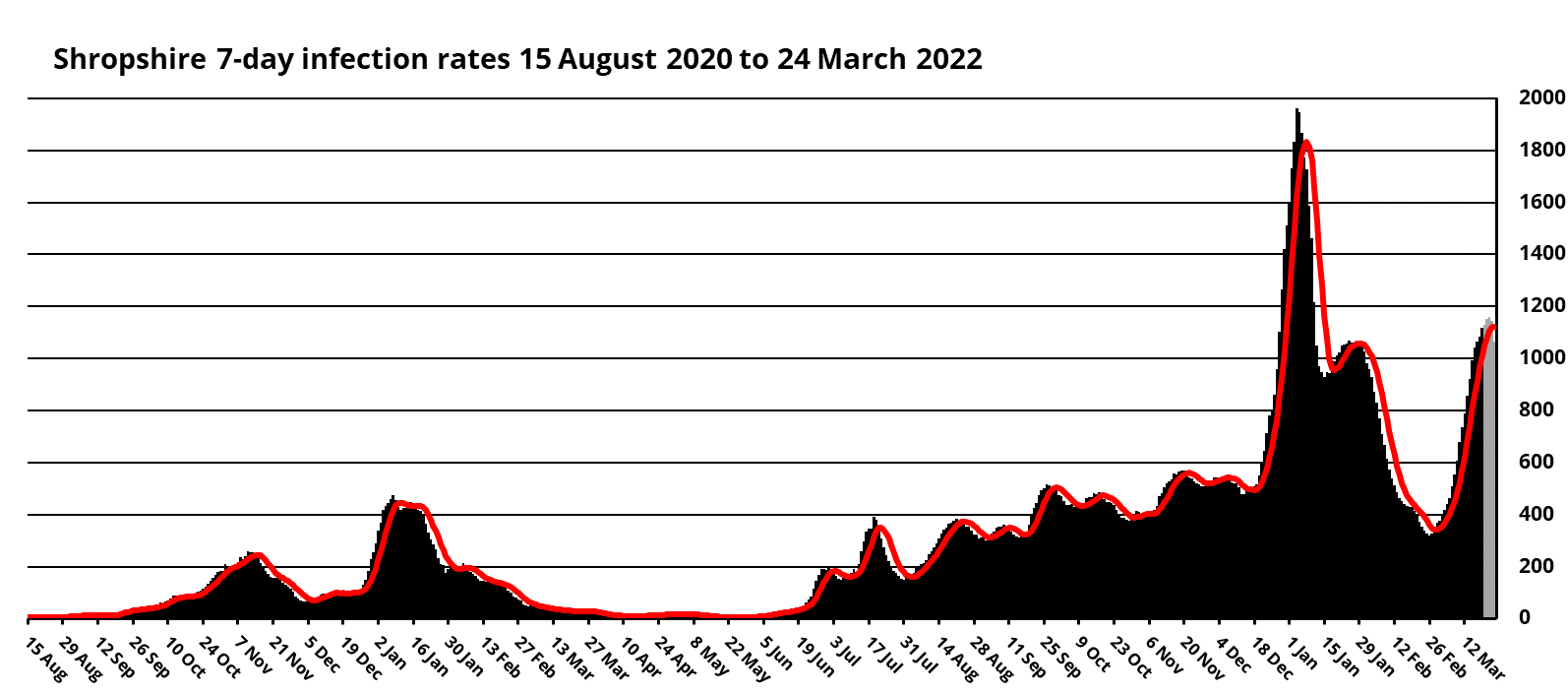It will not be news to many people that Covid-19 infections are once again soaring. This is due to a new variant of Omicron (Ba.2), which is even more infectious than the original variant (BA.1). In Shropshire, the current estimated infection rate is estimated to be around 1,065 infections per 100,000 people, higher than the delta phase last year but lower than the peak of 1,814 infections per 100,000 people in early January.
The Office of National Statistics estimates that 3,485,700 people in England had Covid-19 in the week to 17 March (6.4% of population).
In Ludlow, the latest estimated rate of infection to 20 March was 967 per 100,000 people, not far below the county rate.
More than 40,000 people in Shropshire take a Covid test each week. I am concerned that this will fall with the government restricting the availability of lateral flow tests. These must be purchased after the end of this month. If testing reduces, how are we going to identify the next surge in cases and the potential impact on health services and the economy.
It will not be news to many people that Covid-19 infections are once again soaring. This is due to a new variant of Omicron (Ba.2), which is even more infectious than the original variant (BA.1). In Shropshire, the current estimated infection rate is estimated to be around 1,065 infections per 100,000 people, higher than the delta phase last year but lower than the peak of 1,814 infections per 100,000 people in early January.
The Office of National Statistics estimates that 3,485,700 people in England had Covid-19 in the week to 17 March (6.4% of population).
In Ludlow, the latest estimated rate of infection to 20 March was 967 per 100,000 people, not far below the Shropshire count.
More than 40,000 people in Shropshire take a Covid test each week. I am concerned that this will fall with the government restricting the availability of lateral flow tests. These must be purchased after the end of this month. If testing reduces, how are we going to identify the next surge in cases and the potential impact on health services and the economy.
Testing and antibodies

There were more than 7,200 PCR in Shropshire tests in the week to 17 March of which 23% were positive for Covid-19. There were also more than 33,000 lateral flow tests.
In the week beginning 28 February, it is estimated that 99% of people in England had antibodies to Covid-19:
- Aged 8-11: 81%
- Aged 12-15: 96%
- Aged 16-24: 98%
- Aged 25 and over: 99%.
Infection rates are increasing in many countries worldwide, including here in the UK. An editorial in the journal Nature last week argued that now is not the time to reduce testing and scaling back virus surveillance at this time is short-sighted. However, the political decisions have been made. The government here and in other countries, have taken their eye off Covid as they attempt to deal with the cost of living crisis and the war in Ukraine. Let’s hope that is the right move.
Variants
Scientists first identified the BA.2 subvariant back in December 2021, when they discovered that the original omicron lineage (BA.1) had split in two. There have been other sublineages of Omicron but BA.2 raised concerns because it is more transmissible that BA.1. Reassuringly, BA.2 isn’t more likely to cause severe disease and hospitalization compared with BA.1.
In the week to 12 March, BA.2 was estimated to have caused 79% of Covid-19 cases in Shropshire and Telford & Wrekin, and 86% of cases in England.
As some of you will know from personal experience, you can catch Covid-19 twice. In England, more than 650,000 people have probably been infected twice, most of them in the past two months by Omicron. If you had been infected with Omicron BA.1, it is unlikely you will be reinfected with BA.2.
We are far from seeing the end of new variants. Deltacron, a hybrid of delta and omicron, has recently been discovered.
Hospitals
In the two SaTH hospitals, 727 people died while infected with Covid-19 up to 17 March 2022, 67 this year.
In the seven days to 20 March, an average of 78 beds in Shropshire’s hospitals were occupied by people with Covid-19. That includes 100 beds in the community hospitals, 557 at SaTH and seven at Gobowen. At SaTH, which is at the heart of the ambulance crisis, 11% of general and acute beds were occupied by patients with Covid-19, 82% by other patients and 7% of beds were unoccupied. One patient was in a critical care bed with Covid.













